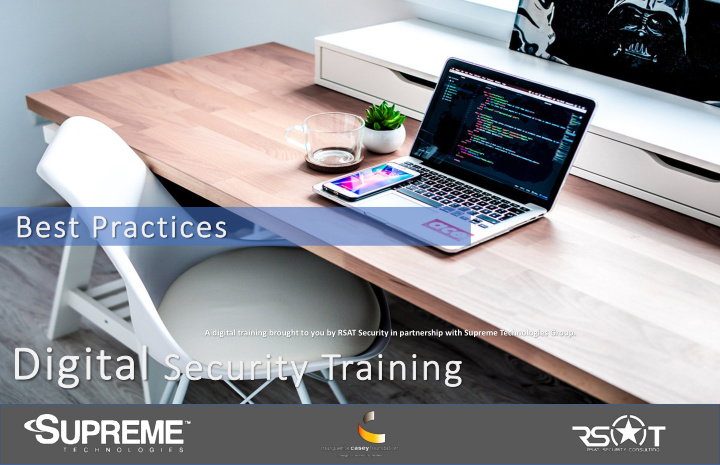



Be Best Practices A digital training brought to you by RSAT Security in partnership with Supreme Technologies Group. Digit Digital al Se Security y Training
Topics Covered Week 5 Week 1 Social Media Introduction to Information Security Week 6 Week 2 Responsible Organizations Use of Information Email Security Week 3 Week 7 Data Leakage & How to prevent it Mobile Device Security Week 4 Week 8 Responsible Use of the Internet – Clean Desk Policy - Recap Protecting your identity
WEEK #8 Clean Desk Policy Recap
What is a Clean Desk Policy? A clean desk policy ensures that all important documents, confidential letters, binders, books, etc are removed from a desk and locked away when the items are not in use or an employee leaves his/her workstation. It is one of the top strategies to utilize when trying to reduce the risk of security breaches. Having a clean desk helps to not only eliminate clutter, but also helps prevent the likelihood that anyone can gain access to your company’s information or the information of your clients.
What is a Clean Desk Policy? So what are we saying? Basically, the Clean Desk Policy is all about being aware of your valuable information and the Threats to it!
Ex Externa nal thr threats ts to your ur Informa mati tion Four of the biggest external threats to our organizations today are: Phishing Social Engineering Ransomware Unsecure Wifi
Ph Phishing • Phishing refers to the practice of creating fake emails that appear to come from someone you trust, such as: - Bank - Credit Card Organization - Popular Websites • The email will ask you to “confirm your account details or your vendor’s account details”, and then direct you to a website that looks just like the real website, but whose sole purpose is to steal information.
So Social Engineering – Ph Phishing Video https://www.youtube.com/watch?v=PWVN3Rq4gzw
So Social Engineering • When attempting to steal information or a person’s identity, a hacker will often try to trick you into giving out sensitive information rather than breaking into your computer. • Social Engineering can happen: - By baiting - Over the phone - By text message - Email (Also called phishing)
So Social Engineering – Ov Over er the e Phone • Social Engineering over the phone is becoming a very popular tool to exploit your weakness for the purpose of getting access to your private information. They typically do the following: - You may get a call from someone claiming to be from Microsoft (A popular organization. Most likely you are using some form of Microsoft software). They attempt to win your trust by either frightening you then letting you know that they can protect you. For example, they claim that they received a message that your computer is compromised, and they have to login to your system to fix it. - Once you give them access, they will install a real virus on your computer and then ask you to pay them to remove the virus. If you decline to pay, they will attempt to activate the virus that they installed on your computer out of vengeance to destroy your computer.
So Social Engineering – Ov Over er the e Phone Videos • https://www.youtube.com/watch?v=lc7scxvKQOo&t=46s
Ra Ransomware • Ransomware is a type of malware (malicious software) which criminals use to extort money. It holds data to ransom using encryption or by locking users out of their device. • Often, systems are infected by ransomware through a link in a malicious email. When the user clicks the link, the ransomware is downloaded to the user’s computer, smartphone or other device. Ransomware may spread through connected networks.
Ra Ransomware Videos https://www.youtube.com/watch?v=VX59Gf-Twwo
WEEK #8 Mobile Device Security Unsecured WiFi
Mobile Device Security – Da Data Leakage Unsecured WiFi A major risk of connecting to an unsecured Wi-Fi connection comes from using services that require login information. Data transmitted over unsecured Wi-Fi can be intercepted by third parties. These third parties can extract your login information and passwords from this intercepted data and use it to fraudulently access your services.
Mobile Device Security – Da Data Leakage Unsecured WiFi There is just 1 solution to the threats of using unsecured wireless networks……Don’t use them. Just turn on your hotspot feature on your cell phone and use that as your WiFi if needed.
Mobile Device Security - Unsecured WiFi Videos https://www.youtube.com/watch?v=lFo49yL06Qg
Pa Password Manager recommendations Three of the top recommended password managers (Specifications are on the cheat sheet):
Time for Q&A
For additional support for your organization, please email us at rsatinfo@rsatsecurity.com rsatinfo@rsatsecurity.com (212) 634-7276 est. 702 www.rsatsecurity.com
Recommend
More recommend